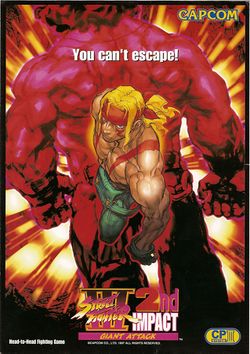
| Street Fighter III: 2nd Impact | |
|---|---|
| Developer(s) | Capcom |
| Publisher(s) | Capcom |
| Year released | 1998 |
| System(s) | Arcade |
| Preceded by | Street Fighter III |
| Followed by | Street Fighter III: 3rd Strike |
| Series | Street Fighter |
| Japanese title | ストリートファイターIII 2nd IMPACT |
|---|---|
| Genre(s) | Fighting |
| Players | 1-2 |
| Modes | Single player, Multiplayer |
Street Fighter III: 2nd Impact was the second of three versions of the Street Fighter III series. It expands the cast by two selectable fighters, and one hidden fighter, none other than Akuma. Much like the Street Fighter Alpha series, this second version is more of a reimaging of the first game than a sequel, replacing the events that took place in the first game with the ones that happen here.
Hugo and Urien are the two new fighters. Hugo is actually taken straight from Capcom's Final Fight series, as one of the hulking Andore family, along with his wrestling manager, Poison. Urien is actually the younger brother of the Street Fighter III boss, Gill, with an ax to grind. Among the cast changes, Yun is given a distinct character selection space from his brother Yang, and they become independent characters with similar, but differing move sets.
Parries are still the new feature of the game, but 2nd Impact also brings another new feature, transported over from the Darkstalker series: the concept of EX moves. Some special moves can be enhanced by pressing more than one button when executing the move. The cost of performing an EX move is a small portion of your Super Art gauge. This expands available strategy by forcing players to choose between spending power on single Super Art attacks or a barrage of EX moves.
-
Title screen
Table of Contents
- Street Fighter III
- 2nd Impact
- 3rd Strike (Online Edition))
